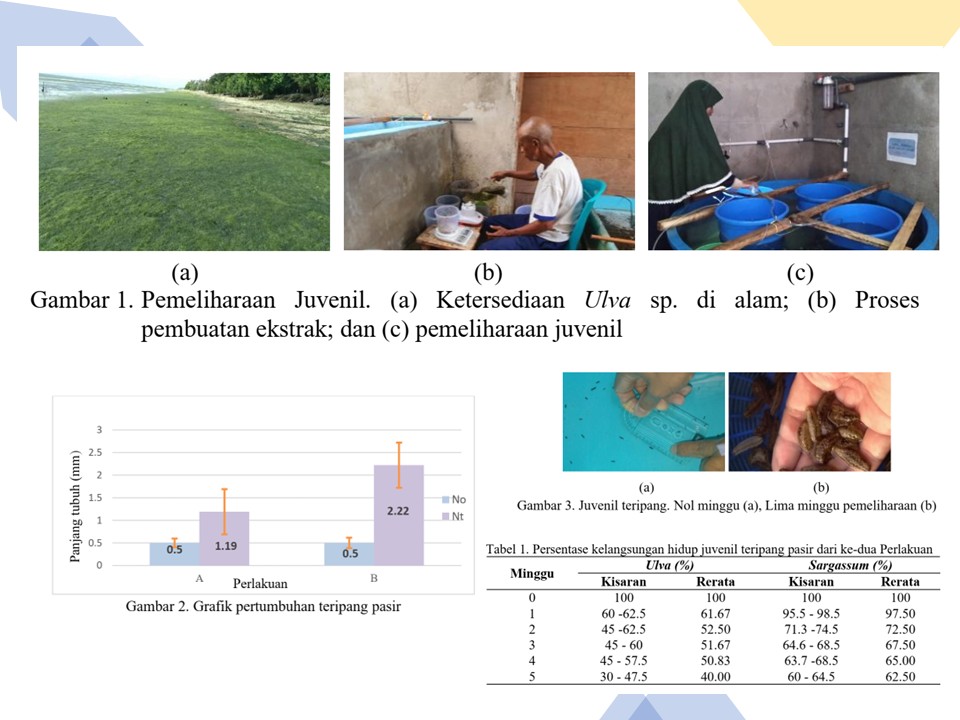Comparison of the performance juvenile sandfish, Holothuria scabra fed Ulva and Sargassum
DOI:
https://doi.org/10.46252/jsai-fpik-unipa.2024.Vol.8.No.4.390Keywords:
growth, sandfish, sargassum, ulvaAbstract
Sandfish (Holothuria scabra) are one of the economically important marine animals found in the coastal of the Kei Islands (Tual City and Southeast Maluku Regency). The large exploitation pressure caused the sandfish population in the Kei Islands to decline drastically. This problem can be overcome by farming activities (greeding, nursery and grow-out). Nursery is an important segment in the farming series because through nursery the seeds are prepared to a size that good for rearing in grow-out containers or restocking into nature. This research aims to see the effect of giving Sargasum sp and Ulva sp extracts on the growth and survival of sandfish juveniles. This research doing from August – September 2022 at the Tual Teripang Center, Ohoitel village, Tual City. Juvenile sandfish used as research objects size 3 – 6 mm and stocking density is 40 individu per container. The feed used as treatment was Ulva sp extract 50 g/container (treatment A) and Sargasum sp extract 50 g/container (treatment B). Feeding is done every day and water changes are 70-100% per day. The calculation of growth and survival rate is the variable that observed in this study. The average absolute growth in body length in treatment A was 0.69 mm and in treatment B was 1.72 mm. Through the T test on growth, it was obtained that Pvalue (0.0006) < α (0.05) which means that the two treatments had different effects on juvenile growth. For survival, the average percentage for Treatment A was 40% and Treatment B was 62.5%. Through the T test on survival, it was obtained that Pvalue (0.0048) < α (0.05) which means that the two treatments had different effects on the survival of juvenile sea cucumbers. It was concluded that treatment B was better for the growth of juvenile sandfish than treatment A.
Downloads
References
Direktorat Konservasi dan Keanekaragaman Hayati Laut. (2015). Rencana Aksi Nasional (RAN) Konservasi Teripang Periode I : 2016-2020. Direktorat Konservasi dan Keanekaragaman Hayati Laut, Direktorat Jenderal Penelolaan Ruang Laut, Kementerian Kelautan dan Perikanan.
Dwiono S.A.P. (2022). Implementation of sea cucumber cultivation technology on industrial scale. Webinar. 32 slide.
Firdaus M and L.F. Indriana. (2019). Nursery performance of sandfish Holothuria scabra juveniles in tidal earthen pond using different types of cage. The 2nd International Symposium on Marine Science and Fisheries. Hal 1 – 7.
Giri N.A, S.B.M Sembiring, M Marzuqi, and R Andamari. (2017). Formulation and application of artificial seaweed-based diets for nursery of sea cucumber (Holothuria scabra) juveniles. Jurnal Riset Akuakultur. 12 (3) : 263-273
Indriana. L.F, Firdaus M, Suprono and Munandar H. (2017). Survival rate and growth of juvenile sandfish (Holothuria scabra) in various rearing conditions. Journal Marine Research in Indonesia. 42 (1) : 11 – 18.
Kurnianto D, Indriana L.F, Wahab A, Hafid S and Badi B.F. (2020). Growth and survival of sandfish Holothuria scabra juveniles grown with and without seaweed Gracilaria sp., using floating and fixed hapas in earthen pond. Jurnal Oseanologi dan Limnologi di Indonesia. 5(3): 199-208
Kurnianto D, Indriana L.F, Suparmo, Tarmin N, Wahab A, Badi B.F, Pesilette R.N and Jasmadi. (2021). The Preference of the sandfish Holothuria scabra on macroalgae-based feed. Jurnal Oseanologi dan Limnologi di Indonesia. 6 (3): 179 -189
Lavitra T, Tsiresy G, Rasolofonirina R and Eeckhaut I. (2015). Effect of nurseries and size of released Holothuria scabra juveniles on their survival and growth. SPC Beche-de-mer Information Bulletin. 35. 37 – 41
Magcanta M. L. M., Sornito M. B., Espadero A. D. A., Bacosa H. P and Wilfredo H. Uy. (2021). Growth, survival and behavior of early juvenile sandfish Holothuria scabra (Jaeger, 1883) in response to feed types and salinity levels under laboratory conditions. Philippine Journal of Science 150 (5): 871-884
Sembiring S B M, Wardana I K, and Haryanti. (2016). Performance of sea cucumber, Holothuria scabra juvenile from different sources of broodstock. Jurnal Riset Akuakultur 11 (2): 147-154
Sembiring S.B.M, Wibawa G.S, Giri I.A, Hutapea J.H and Haryanti. (2018). Reproduction and larvae rearing of sandfish (Holothuria scabra). Marine Research. Indonesia Journal. 43 : 11-17
Tomatala Pitjont, Letsoin P. P, and Kadmaer E.M.Y. (2020). The nursery technique of juvenile sandfish, Holothuria scabra. Jurnal Ilmiah Platax. 8 (1): 89 – 94.
Tomatala Pitjont, Haryadi D, Arianto D and Pattiwael S. (2022). The effectiveness of the nursery method for juvenile of sea cucumbers in household scale hatcheries. Jurnal TRITON. 18 (1). 20 – 27
Tomatala Pitjont, Beruatwarin R J, Haryadi D, Arianto D, Pattiwael S and Damayanto M Z. (2023). Application of Sargassum sp extract on juvenile sandfish nursery. International Conference on Sustainable Blue Economy. IOP Publishing 12 (7) : 1 – 6

Downloads
Published
How to Cite
Issue
Section
License
Copyright (c) 2024 Pitjont Tomatala, Soraya Kalean, Dwi Arianto, Steven Pattiwael

This work is licensed under a Creative Commons Attribution-ShareAlike 4.0 International License.


















